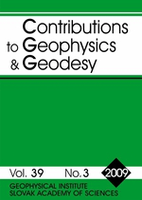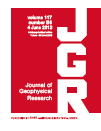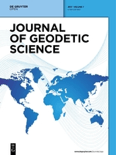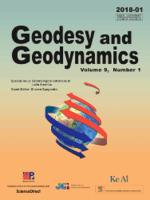
STUDIA GEOPHYSICA ET GEODAETICA
Scope & Guideline
Fostering Dialogue in the Heart of Earth Science Research
Introduction
Aims and Scopes
- Geophysical Analysis and Modeling:
The journal emphasizes research that involves the analysis and modeling of geophysical phenomena, including seismic activity, gravitational fields, and magnetic properties of geological formations. It often employs advanced computational techniques and statistical methods to interpret complex geophysical data. - Geodetic Techniques and Applications:
Research published in the journal frequently focuses on the development and application of geodetic techniques, such as GNSS (Global Navigation Satellite Systems), remote sensing, and gravity field modeling. These studies aim to enhance the precision of measurements and contribute to various scientific and practical applications. - Interdisciplinary Approaches:
The journal encourages interdisciplinary studies that integrate geophysics with other fields such as environmental science, geology, and engineering. This approach aims to provide comprehensive insights into Earth processes and the implications for natural resource management and disaster mitigation. - Innovative Methodologies:
A significant aspect of the journal is the introduction and validation of innovative methodologies, including machine learning and deep learning techniques for data processing, noise suppression, and predictive modeling in geophysical research.
Trending and Emerging
- Machine Learning and Data Science in Geophysics:
There is a growing trend towards the application of machine learning and data science techniques in geophysical research. This includes the use of deep learning for seismic noise suppression and predictive modeling, indicating a shift towards more computationally intensive and data-driven approaches. - Climate Impact Studies:
Research examining the effects of climate events, such as volcanic eruptions, on atmospheric conditions and geophysical measurements is gaining prominence. This theme underscores the relevance of geophysical research in understanding climate change and its impacts on Earth systems. - Integrated Geophysical and Geodetic Approaches:
A notable trend is the integration of geophysical and geodetic methods for more comprehensive analyses. This includes combining GNSS data with seismic and remote sensing techniques, highlighting the journal's focus on multidisciplinary research that enhances measurement accuracy and understanding of geophysical processes. - Advanced Numerical Methods and Algorithms:
The emergence of studies focusing on advanced numerical methods for geophysical modeling, such as new algorithms for gravity field modeling and seismic data reconstruction, indicates a trend towards improving computational efficiency and accuracy in geophysical research.
Declining or Waning
- Traditional Geophysical Survey Techniques:
There appears to be a decreasing emphasis on conventional geophysical survey methods, such as basic seismic reflection and refraction techniques. This decline may be due to the rise of more advanced analytic methods that provide better insights and efficiency. - Basic Theoretical Studies:
There is a noticeable reduction in the publication of purely theoretical studies without practical applications or advancements in methodology. The journal seems to favor research that combines theory with empirical results or practical applications. - Geophysical Applications in Limited Regions:
Research focusing on localized geophysical applications, especially those that do not contribute to broader geophysical understanding or do not use advanced methodologies, has seen a decline. The trend indicates a preference for studies with wider implications or that integrate regional data into global contexts.
Similar Journals

Journal of Indian Geophysical Union
Illuminating the Depths of Geophysical ScienceThe Journal of Indian Geophysical Union, published by the Indian Geophysical Union (IGU), serves as a vital platform for disseminating research in the field of geophysics. With the ISSN 0257-7968, this journal primarily focuses on studies related to geophysical sciences, including but not limited to, seismicity, environmental geophysics, and geodynamics, contributing to a better understanding of the Earth's processes. The journal is committed to quality research and aims to foster a collaborative environment for researchers, professionals, and students in India and internationally. Although currently not designated as an Open Access publication, it plays an essential role in connecting academia with practical applications in geophysical research. Based in Hyderabad, India, the Journal of Indian Geophysical Union continues to be an essential resource for those seeking to expand their knowledge and engage with the latest findings in geophysics.

Contributions to Geophysics and Geodesy
Connecting Scholars to Transform Geophysical UnderstandingContributions to Geophysics and Geodesy is a distinguished open access journal dedicated to advancing the field of geophysics and geodesy, published by the SLOVAK ACADEMY OF SCIENCES, EARTH SCIENCE INSTITUTE. With a rich publication history since its inception in 1992 and a commitment to open access since 2009, this journal serves as a vital platform for disseminating innovative research and critical insights in Earth sciences. Although it currently holds a Q4 ranking in the Geophysics category and is positioned in the 29th percentile, it continues to foster scholarly dialogue and enhance the visibility of significant findings in the community. Situated in Slovakia, the journal's address underscores its international reach and relevance. Researchers, professionals, and students alike will find valuable resources and perspectives within its pages, aiming to bridge gaps in knowledge and contribute meaningfully to the ongoing global discourse in geophysical sciences.

Geofizika
Innovating Earth Sciences with Every IssueGeofizika, an esteemed journal published by the Andrija Mohorovičić Geophysical Institute at the University of Zagreb, presents a significant platform for research in the fields of geophysics and Earth sciences. With an Open Access model established since 1984, this journal ensures that scientific knowledge is accessible to a broad audience, encouraging collaborations and the free exchange of ideas. Geofizika has steadily evolved through its converging years from 1989 to 1999 and has been active from 2003 to the present, reflecting its commitment to advancing geophysical research. The journal has been recognized for its contributions to Earth and Planetary Sciences and has acquired respectable ranks in various categories; notably, it holds a Q4 status in Geophysics as of 2023. Researchers, professionals, and students will find Geofizika a valuable resource for the latest discoveries and methodologies in geophysics, supporting the academic community in expanding the frontiers of knowledge in these vital scientific domains.

JOURNAL OF GEOPHYSICAL RESEARCH-SOLID EARTH
Connecting Scholars to the Core of Earth ScienceJOURNAL OF GEOPHYSICAL RESEARCH-SOLID EARTH is a prestigious journal published by the American Geophysical Union, dedicated to advancing the study of solid Earth sciences. With an ISSN of 2169-9313 and E-ISSN of 2169-9356, it serves as a leading platform for rigorous research findings and innovative advancements within the fields of Earth and Planetary Sciences, Geochemistry and Petrology, Geophysics, and Space and Planetary Science. The journal has achieved an impressive Q1 quartile ranking across these categories, reflecting its high impact in the academic community and underscoring its role in influencing scientific discourse. Notably, it holds an esteemed position in Scopus, ranking 15th among 159 journals in Earth and Planetary Sciences (miscellaneous) as well as within the top 20 in several other geophysical domains. Researchers and practitioners are encouraged to contribute their work to this esteemed journal, which publishes comprehensive articles from 1979 to the present, thus providing a crucial repository of knowledge for those engaged in solid Earth research. Although it does not currently offer Open Access options, the journal's prestigious reputation ensures its articles reach a wide audience of academics, professionals, and students alike, fueling a deeper understanding of our planet's processes and challenges.

Applied Geophysics
Pioneering Discoveries in Applied GeophysicsApplied Geophysics is a premier journal dedicated to the interdisciplinary study of geophysical processes and their applications across various domains, published by SPRINGER. With an ISSN of 1672-7975 and an E-ISSN of 1993-0658, this journal serves as a pivotal platform for researchers, professionals, and students to share their latest findings and insights in the field of geophysics. Operating from China, the journal has established itself within the Q3 quartile in Geophysics as of 2023, reflecting its commitment to high-quality research, even as it ranks #105 out of 165 in the Earth and Planetary Sciences category, placing it in the 36th percentile on Scopus rankings. This makes it an essential resource for advancing knowledge in geophysical methodologies and applications. While it operates in a traditional subscription model, its relevance and timeliness ensure it remains a crucial outlet for emerging scientific discussions. The journal particularly encourages the integration of practical applications with theoretical frameworks, fostering innovation in areas such as environmental geophysics, resource exploration, and hazard assessment.

International Journal of Geophysics
Pioneering Research in Earth’s Physical Properties and Water DynamicsInternational Journal of Geophysics, published by HINDAWI LTD, represents a significant platform in the field of geophysical research and water science. Established as an Open Access journal in 2009, it has committed itself to disseminating groundbreaking studies and innovations that enhance the scientific understanding of the Earth’s physical properties and water dynamics. With a presence in Egypt, this journal maintains a global appeal, supported by its inclusion in prestigious indices, achieving a Q3 ranking in Geophysics and Water Science and Technology as of 2023. Although the H-Index is currently not listed, the journal showcases a reputable ranking in Scopus, placing it in the 34th percentile for Earth and Planetary Sciences and the 26th percentile in Environmental Science. The journal's scope covers a broad range of interdisciplinary topics, making it an invaluable resource for researchers, professionals, and students aiming to stay at the forefront of geophysical advancements and sustainable water resource management. By offering open access to its content, the International Journal of Geophysics ensures that critical research is accessible to a wide audience, fostering collaboration and innovation across global scientific communities.

Solid Earth Sciences
Innovating research for a sustainable Earth.Solid Earth Sciences is a dynamic open-access journal published by Elsevier, dedicated to advancing our understanding of the Earth's subsurface processes and materials. Since its inception in 2016, the journal has established itself as a vital resource for researchers and professionals in the fields of geochemistry, petrology, geology, geophysics, and geotechnical engineering, achieving a notable Q2 ranking in multiple categories as of 2023. With an ISSN of 2451-912X, the journal aims to disseminate high-quality research that enhances knowledge of earth surface processes and the intricate interactions within our planet's systems. The journal is indexed in Scopus, showcasing an impressive rank in various sub-disciplines, with a rank of #96 in Geology and a noteworthy percentile in Earth and Planetary Sciences. Solid Earth Sciences offers a platform for innovative studies, comprehensive methodologies, and cutting-edge technological advancements that cater to a global audience of scientists, academics, and students. With its commitment to open access, it fosters wider dissemination and impact of research outcomes, ensuring that pivotal discoveries reach stakeholders and contribute to real-world applications.

Journal of Geodetic Science
Exploring New Frontiers in Geodetic Science and Application.Journal of Geodetic Science, published by DE GRUYTER POLAND SP Z O O, is a premier academic journal dedicated to the advancement of the field of geodesy and its interconnected disciplines. As an Open Access journal since 2011, it ensures that high-quality research is readily accessible to researchers, practitioners, and students alike. With an ISSN of 2081-9919 and an E-ISSN of 2081-9943, this journal plays a critical role in disseminating innovative findings related to geophysical phenomena, applied mathematics, and Earth sciences. Currently ranked in the Q3 category across multiple disciplines such as Applied Mathematics and Geophysics, the journal's Scopus rankings reflect its growing impact in the academic community, with noteworthy positions in Earth and Planetary Sciences and Astronomy. The Journal of Geodetic Science not only fosters cutting-edge research but also promotes interdisciplinary collaboration, ultimately contributing to advancements in understanding our planet and improving geodetic applications.

Geodesy and Geodynamics
Navigating the Landscape of Geodesy and Geodynamics.Geodesy and Geodynamics is a premier open-access journal dedicated to the interdisciplinary fields of geodesy and geodynamics, published by KEAI PUBLISHING LTD. With a commitment to accessibility since 2010, this journal serves as an essential platform for researchers, professionals, and students in understanding the Earth's structure, dynamics, and geophysical processes. Based in China, it has rapidly gained recognition, earning a commendable Q2 ranking in various categories, including Computers in Earth Sciences, Earth-Surface Processes, and Geophysics. The journal covers critical advances in theory and practice, making significant contributions to the study of planetary sciences. Researchers can benefit from a robust readership and impactful dissemination of their work, as evidenced by its solid positions in Scopus rankings. Moving forward, Geodesy and Geodynamics aims to continue fostering innovation and collaboration within the geoscience community through high-quality research and comprehensive review articles.

Geofisica Internacional
Exploring Innovative Solutions for Energy SustainabilityGeofisica Internacional, an esteemed academic journal published by the Instituto de Geofísica at UNAM, Mexico's prestigious National Autonomous University, has been a pivotal platform for advancing the field of geophysics and energy studies since its inception in 1975. This Open Access journal aims to disseminate high-quality research findings, making significant contributions to our understanding of Earth's processes and energy resources. With a current impact factor that situates it in the Q3 category for both Energy (miscellaneous) and Geophysics, it provides a continuous dialogue for researchers, professionals, and students interested in the intersection of these critical areas. Based in Mexico City and publishing articles that span various geophysical disciplines, Geofisica Internacional is indispensable for anyone seeking to stay at the forefront of environmental and energy research.